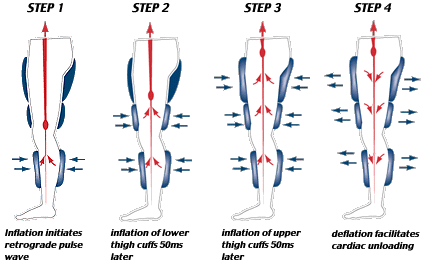Patient receiving EECP treatment.jpg

Michigan Medicine heart patient George Forbes receiving EECP treatment.
What Is EECP?
Enhanced External Counter Pulsation (EECP) is performed as a non-invasive treatment to lower the number and intensity of angina episodes. Treatment is administered through three pairs of external inflatable cuffs that are applied around the lower legs, upper legs and buttocks. These cuffs continuously inflate and deflate between the resting period of the heartbeat and increase blood returned to the heart.

The basic principle of EECP treatment involves increasing the amount of blood returning to the heart, which helps supply more oxygen to its starved areas. With more oxygen available, the heart can function much more efficiently and therefore reduce chest pain.
The treatment schedule includes 7 weeks of continuous treatments, which require daily visits for one hour, Monday through Friday.
History of EECP Treatment
EECP treatment originated in China where it has been extensively used since the 1960s. In the past 10 years it has been introduced to the United States, where there are currently around 1200 machines in operation. The idea for EECP stemmed from the development of the intra-aortic balloon pump (IABP). IABP resulted in increasing the amount of blood that can get pumped out of the heart by inflating a balloon in the aorta between each heartbeat. Opening up the aorta allows more blood flow and therefore decreases how hard the heart has to work. This same theory is applied to EECP but is taken one step further. EECP Increases the amount of blood going back to the heart, providing more blood for the heart to work with. This also decreases how hard the heart has to work but on a much greater scale, especially for people with damaged heart tissue.
Who Is Eligible for EECP Treatment?
Individuals are eligible for treatment if they have been diagnosed with disabling stable angina (Class III or IV Canadian Cardiovascular Society or equivalent classification), who in the opinion of a cardiologist or cardiothoracic surgeon, are not readily amenable to surgical intervention because:
- Their condition is inoperable, or at high risk of operative complications or postoperative failure;
- Their coronary anatomy is not readily amenable to such procedures; or
- They have co-morbid states, which create excessive risk.
Who Should Not Seek EECP Treatment?
Patients who should not undergo EECP include those with:
- Hypertrophic cardiomyopathy
- Congenital heart disease
- Valvular disease
- Enlarged heart
- Pacemaker
- Hemorrhage
- Atrial fibrillation (Afib)
- Pulmonary hypertension
- Clot in their body
- Peripheral artery disease (PAD), also called peripheral vascular disease (PVD)
- Severe elevated blood pressure
- Heart rate greater than 120 beats per minute
What Are the Benefits of EECP Treatment?
- Increased oxygen supply for the heart
- Decrease in chest pain
- Improved EKG response to exercise
- Decrease in nitroglycerin use
- Increase in energy
- Increased exercise duration
- Long term effects up to 2 years
Patient Resources
Questions About EECP?
If you have been referred to EECP treatment and would like to schedule treatment at the University of Michigan, please contact us at 734-998-9590. See the EECP Program Overview section below for further details about the U-M EECP Program, or visit the EECP Treatment Patient Story page to read about U-M patient George Forbes' experience with EECP treatment.
University of Michigan EECP Program Overview
Michigan Medicine Preventive Cardiology offers a combination of EECP and cardiac rehabilitation during the same visit to maximize a patient’s time commitment. This has proved to be effective in enhancing wellness as patients are given the opportunity to undergo EECP treatment, exercise and learn about nutrition, stress management and strategies for behavior change.
Pre-EECP Treatment
Before beginning EECP, you should:
- Get a physician referral
- Schedule your pre-treatment appointments, which include:
- Nursing assessment
- Stress test
- Orientation to procedures and equipment
Nursing Assessment
The nursing assessment will include a review of medical history, contraindications to treatment and clearing the individual for treatment. During this assessment they will be given an angina diary which will be used to record frequency and duration of chest pain episodes. During the nursing assessment, the individual will receive comprehensive information about EECP treatment and procedures and will complete several questionnaires to assess severity of chest pain.
Stress Test
Individuals will complete a stress test prior to beginning EECP treatment. This will establish their exercise capacity and provide final clearance to begin treatment. More importantly, it will identify the severity, frequency and duration of chest pain with exercise.
After completing 35 treatment sessions, there will be another stress test measuring the same values. The two stress tests will be compared, which will indicate any changes in chest pain and exercise capacity.
Orientation
The orientation is designed to give an individual the chance to experience exactly what treatments will be like. There will be an orientation to the room, a full explanation of the treatment sessions, education about the treatment process, and a 15-minute trial of the ECP machine in operation. Any questions about the treatment will also be addressed at this time. The first official treatment session will begin the next day at a specified time.
